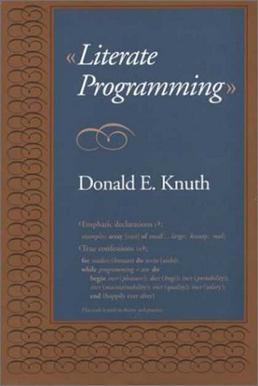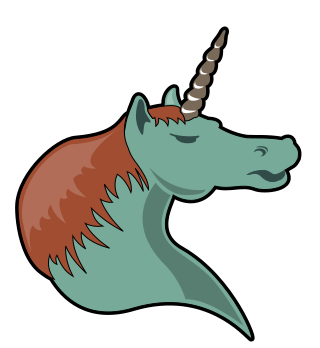
Donald Ervin Knuth is an American computer scientist, mathematician, and professor emeritus at Stanford University. He is the 1974 recipient of the ACM Turing Award, informally considered the Nobel Prize of computer science. Knuth has been called the "father of the analysis of algorithms".

Literate programming is a programming paradigm introduced in 1984 by Donald Knuth in which a computer program is given as an explanation of how it works in a natural language, such as English, interspersed (embedded) with snippets of macros and traditional source code, from which compilable source code can be generated. The approach is used in scientific computing and in data science routinely for reproducible research and open access purposes. Literate programming tools are used by millions of programmers today.

LaTeX is a software system for document preparation. When writing, the writer uses plain text as opposed to the formatted text found in WYSIWYG word processors like Microsoft Word, LibreOffice Writer and Apple Pages. The writer uses markup tagging conventions to define the general structure of a document, to stylise text throughout a document, and to add citations and cross-references. A TeX distribution such as TeX Live or MiKTeX is used to produce an output file suitable for printing or digital distribution.
In computer science, pseudocode is a plain language description of the steps in an algorithm or another system. Pseudocode often uses structural conventions of a normal programming language, but is intended for human reading rather than machine reading. It typically omits details that are essential for machine understanding of the algorithm, such as variable declarations and language-specific code. The programming language is augmented with natural language description details, where convenient, or with compact mathematical notation. The purpose of using pseudocode is that it is easier for people to understand than conventional programming language code, and that it is an efficient and environment-independent description of the key principles of an algorithm. It is commonly used in textbooks and scientific publications to document algorithms and in planning of software and other algorithms.
TeX, stylized within the system as TeX, is a typesetting system which was designed and written by computer scientist and Stanford University professor Donald Knuth and first released in 1978. TeX is a popular means of typesetting complex mathematical formulae; it has been noted as one of the most sophisticated digital typographical systems.

A text editor is a type of computer program that edits plain text. Such programs are sometimes known as "notepad" software. Text editors are provided with operating systems and software development packages, and can be used to change files such as configuration files, documentation files and programming language source code.
Metafont is a description language used to define raster fonts. It is also the name of the interpreter that executes Metafont code, generating the bitmap fonts that can be embedded into e.g. PostScript. Metafont was devised by Donald Knuth as a companion to his TeX typesetting system.

The device independent file format (DVI) is the output file format of the TeX typesetting program, designed by David R. Fuchs and implemented by Donald E. Knuth in 1982. Unlike the TeX markup files used to generate them, DVI files are not intended to be human-readable; they consist of binary data describing the visual layout of a document in a manner not reliant on any specific image format, display hardware or printer. DVI files are typically used as input to a second program which translates DVI files to graphical data. For example, most TeX software packages include a program for previewing DVI files on a user's computer display; this program is a driver. Drivers are also used to convert from DVI to popular page description languages and for printing.

BibTeX is reference management software for formatting lists of references. The BibTeX tool is typically used together with the LaTeX document preparation system. Within the typesetting system, its name is styled as . The name is a portmanteau of the word bibliography and the name of the TeX typesetting software.
MetaPost refers to both a programming language and the interpreter of the MetaPost programming language. Both are derived from Donald Knuth's Metafont language and interpreter. MetaPost produces vector graphic diagrams from a geometric/algebraic description. The language shares Metafont's declarative syntax for manipulating lines, curves, points and geometric transformations. However,

Computers and Typesetting is a 5-volume set of books by Donald Knuth published in 1986 describing the TeX and Metafont systems for digital typography. Knuth's computers and typesetting project was the result of his frustration with the lack of decent software for the typesetting of mathematical and technical documents. The results of this project include TeX for typesetting, Metafont for font construction and the Computer Modern typefaces that are the default fonts used by TeX. In the series of five books Knuth not only describes the TeX and Metafont languages, he also describes and documents the source code of the TeX and Metafont interpreters, and the source code for the Computer Modern fonts used by TeX. The book set stands as a tour de force demonstration of literate programming.
Clarion is a commercial, proprietary, fourth-generation programming language (4GL), multi-paradigm, programming language and integrated development environment (IDE) from SoftVelocity used to program database applications. It is compatible with indexed sequential access method (ISAM), Structured Query Language (SQL), and ActiveX Data Objects (ADO) data access methods, reads and writes several flat file desktop database formats including ASCII, comma-separated values (CSV), DOS (binary), FoxPro, Clipper, dBase, and some relational databases via ODBC, Microsoft SQL Server, Sybase SQL Anywhere, and Oracle Database through the use of accelerated native database drivers, and XML, Clarion can be used to output to HTML, XML, plain text, and Portable Document Format (PDF), among others.
Ctags is a programming tool that generates an index file of names found in source and header files of various programming languages to aid code comprehension. Depending on the language, functions, variables, class members, macros and so on may be indexed. These tags allow definitions to be quickly and easily located by a text editor, a code search engine, or other utility. Alternatively, there is also an output mode that generates a cross reference file, listing information about various names found in a set of language files in human-readable form.
ALGOL 60 is a member of the ALGOL family of computer programming languages. It followed on from ALGOL 58 which had introduced code blocks and the begin and end pairs for delimiting them, representing a key advance in the rise of structured programming. ALGOL 60 was one of the first languages implementing function definitions. ALGOL 60 function definitions could be nested within one another, with lexical scope. It gave rise to many other languages, including CPL, PL/I, Simula, BCPL, B, Pascal, and C. Practically every computer of the era had a systems programming language based on ALGOL 60 concepts.

Knuth reward checks are checks or check-like certificates awarded by computer scientist Donald Knuth for finding technical, typographical, or historical errors, or making substantial suggestions for his publications. The MIT Technology Review describes the checks as "among computerdom's most prized trophies".
TeX font metric (TFM) is a font file format used by the TeX typesetting system. It is a font metric format, not an outline font format like TrueType, because it provides only the information necessary to typeset the font such as each character's width, height and depth. The actual glyphs are stored elsewhere. This is not unique to TeX; Adobe's AFM files and Windows' PFM files use the same technique.
In computer science, bootstrapping is the technique for producing a self-compiling compiler – that is, a compiler written in the source programming language that it intends to compile. An initial core version of the compiler is generated in a different language ; successive expanded versions of the compiler are developed using this minimal subset of the language. The problem of compiling a self-compiling compiler has been called the chicken-or-egg problem in compiler design, and bootstrapping is a solution to this problem.
Noweb, stylised in lowercase as noweb, is a literate programming tool, created in 1989–1999 by Norman Ramsey, and designed to be simple, easily extensible and language independent.

In computer programming, a comment is a programmer-readable explanation or annotation in the source code of a computer program. They are added with the purpose of making the source code easier for humans to understand, and are generally ignored by compilers and interpreters. The syntax of comments in various programming languages varies considerably.

Org Mode is a document editing, formatting, and organizing mode, designed for notes, planning, and authoring within the free software text editor Emacs. The name is used to encompass plain text files that include simple marks to indicate levels of a hierarchy, and an editor with functions that can read the markup and manipulate hierarchy elements.









